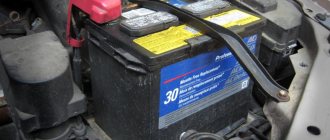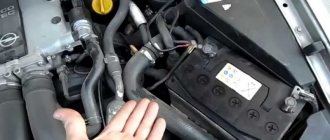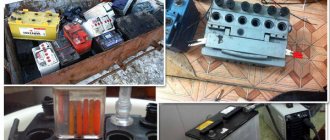In the winter season, the question of how long to charge a car battery becomes especially relevant. A cold start can quickly drain the battery; many motorists solve the problem by replacing the old device with a new one. This solution is not rational and economical. In such a situation, it is wiser to recharge the discharged battery using a special charger.
No specialist can name the exact number of hours required for high-quality charging. It is necessary to focus on the battery capacity, degree of discharge, ambient temperature and other equally important factors.
Preparing the battery for the charging process
One of the main reasons for a decrease in battery capacity is critically low temperature. It is important to take care of the charge level of one of the most important elements in the engine starting system on the eve of the first frost. There is no need to try to invent a device on your own to restore the battery charge level, thereby endangering the safety of yourself and those around you. The right decision would be to purchase special equipment for safe long-term operation. The first step in the charging process is to organize your workspace.
The following requirements are put forward for the room in which the car battery is installed:
- To quickly remove toxic fumes, it must be equipped with ventilation.
- There should be no surges or surges in voltage in the electrical network.
- Availability of necessary fire-fighting equipment.
When a room that meets all the criteria and requirements has been found, you can proceed to the stage of preparing the battery itself. Contacts should be thoroughly cleaned of dirt and oxidation. Then it is recommended to walk over the surface of the device with a soft cloth moistened with ammonia. Also, do not forget about organizing high-quality lighting. At this point, the stage of preparing the battery for recharging can be considered complete.
Can I “light up” from another car?
Charging a car battery with a charger is not always available. In this case, another battery will be useful, which will be a kind of “donor”. This is quite simple to do: you just need to connect the same terminals of the two devices using wires with alligator clips and turn on the motors. This is what most motorists do. This, of course, is a way out of a difficult situation, but often such “lighting up” ends in the failure of the electrical equipment of the car, because this is a completely wrong approach.
To properly replenish the battery charge in the cold, you must:
1. Turn on the engine and warm it up for 5 minutes.
2. Turn off the engine. Remove the terminal from the negative terminal, connect the cigarette lighter wires to the positive and negative terminals of the battery.
3. After this, you can connect to the donor. Turn on the engine, after a few minutes, without turning it off, disconnect the wires for “lighting up”.
To recharge the battery after this, you should drive in a low gear, the engine speed should be approximately 3000 rpm. In this mode, the generator will provide sufficient current to both charge the battery and operate the vehicle's electrical equipment.
How many hours does it take to charge a serviceable battery?
Motorists also wonder: do the batteries need to be removed from the car? In emergency cases, it is problematic to carry out such a procedure, so there is no need. But to fully and effectively recharge the battery, it is necessary to remove it from the car. It is important to remember that the battery must be completely discharged. To do this, just connect several ordinary light bulbs to the terminals of the device and wait for them to go out. To ensure that the time spent on recharging is not wasted, the density and level of the electrolyte in the models being serviced should be measured. In case of deviations from the norm, restore the electrolyte to normal levels.
How long does it take to charge a 60 Ah battery? For standard 60 Ah batteries, the normal current is considered to be 6A. The value can be calculated using the following formula: the current should be 10% of the total capacity. How long the recharging process will take depends largely on a number of factors. In most cases, 12-14 hours is enough. The condition of the electrolyte should be monitored. If it boils, it means the battery is “filled” to capacity.
Some owners increase the amperage, thereby trying to speed up the process. Indeed, things will go faster, but this method significantly worsens the condition of the lead plates. As a result, the battery will exhaust its resource prematurely. The negative impact of increased current primarily concerns batteries with lead plates. It is also necessary to take care of the voltage level; if it is below the nominal value, there will be no charge. The voltage from the charger should be around 13-14V, which is exactly what the car’s generator produces.
About what affects the battery charge
Although most batteries are maintenance-free, they still need to be charged. And this largely depends on the operating conditions of the vehicle. If you travel short distances with frequent stops, turning off the engine and starting it again, this negatively affects the actual battery capacity - it decreases.
In addition, a key role is played by the generator, or rather its operating mode. This is especially true for older cars. The bottom line is that the generator produces its optimal characteristics only when it reaches 2,000 rpm. In other words, the idle mode of operation of the power unit is not capable of properly charging the battery, especially if powerful consumers are involved.
In any case, you should know how many amperes are needed to charge the battery. And from time to time (at least before the onset of winter), you need to charge the battery from another power source. And in this case, special devices are used.
When does a car battery need to be charged?
The installed battery is monitored for open circuit voltage, which should be 12.5 V. The operating voltage is measured at the terminals after the battery is charged on the bench or using a booster. The density of the electrolyte in all banks must be the same, corresponding to the operating conditions of the vehicle. Measurements are taken with the engine running at a shaft speed of 1500-2000 rpm and the high beams on. It is normal if the mains voltage is 13.8 - 14.5 V. Both undercharging and overcharging have consequences for the technical condition of the battery.
For low-maintenance and hybrid batteries, periodic monitoring of the density and electrolyte level is mandatory. Maintenance-free batteries have no caps, are sealed, and can be used as long as they hold a charge. What is important for them is the stability of the network voltage and the absence of discharge to zero.
Battery charge monitoring
By monitoring the battery charging process with a multimeter, you can only get a mediocre idea of what exactly is happening. Of course, it is necessary to know how many amperes to charge the battery, but to obtain more accurate information it is worth measuring the density of the electrolyte. And for this you cannot do without another device, which every driver should have in any case. We are talking about a hydrometer.
The electrolyte density must be measured in each jar, and the degree of charge is assessed based on the resulting average value. Moreover, this characteristic itself should be approximately the same in all containers. However, minor deviations may be present, which is normal.
How to properly charge a dead battery
The charger for a car battery is represented by AC rectifiers. These can be devices that allow regulation of the charging current or voltage. How long will it take to charge a completely dead battery?
If the charging station operates at a constant charging current, a battery with a capacity of 60 A/h is fully charged within 20 hours with a constant current of 6 A.
At a constant current value during the charging period, the voltage increases, which leads to abundant gas release from the electrolyte. Therefore, the supplied direct current is reduced stepwise twice, when the voltage reaches 14.4 and 15 V. That is, control of recharging a dead battery needs monitoring and adjustment.
The method of charging batteries at a constant voltage does not require constant monitoring of the process. The target voltage is set, and the current varies from 40 amperes at the beginning to almost zero at the end of recharging. The recharging time for a completely discharged battery will be 24 hours. But maintenance-free batteries will not receive a full charge. 14.5 V corresponds to 90-95% of the battery capacity.
D.C
This technique is ideal in cases where the battery is heavily discharged. Then it will receive a more complete and uniform charge. Although the process itself is lengthy, this way you can restore the battery capacity to the maximum. The bottom line is that the manipulation consists of several stages, and at the same time the current itself is maintained at a constant level.
This option is not very convenient because it is necessary to constantly monitor the charging process, as well as change the voltage and adjust the current. In other words, simply turning it on and leaving everything for a while will not work. The “set it and forget it” principle is not appropriate here! In addition, the charger should be purchased with the ability to adjust the current.
The battery is dead, how to charge without charging
If the energy of a dead battery after a long period of inactivity is not enough to set the car in motion, charging from external sources will be required. This could be recharging from the battery of another car or using an external energy source in the form of a battery or booster. You may have to use a pusher. How to apply the first pulse charge, in the future the generator will add energy, but after an emergency drop in charge, it is necessary to take measurements and charge the dead battery with a network station.
A battery that has reached zero is charged with a current of 2-3 A. If the voltage at the terminals does not increase within several hours, the battery needs to be replaced.
How to set the battery charge level
Determining battery charge
To determine how charged the battery is, take into account its voltage. You can check this characteristic in two ways:
- Carry out the usual measurement of electrical voltage at the battery terminals. To do this, use a digital voltmeter. This device will allow you to show the exact value of the battery voltage level down to tenths and even hundredths of a volt. To measure, the discharge and charging current must be absent for 4-5 hours so that the voltage returns to a normal stable state. There should be a reading between 12.5 and 12.9 volts. Special chargers with a microprocessor and memory are useful. They allow you to more accurately determine the charge level. Such devices are capable of monitoring the discharge and charge of the battery over several cycles.
- The density of the electrolyte is determined, and this parameter is used to determine the degree of charge of the battery. But this option is only suitable for devices with liquid electrolyte.
Video
We invite you to watch a video on how to properly charge a car, the devices used, and how to properly prepare the equipment for restoration.
The generator supplies the vehicle with energy while driving. When the engine stops, the battery takes over the “feeding” function.
The service life of this unit lasts on average 2-3 years (equivalent to 80-100 thousand kilometers). The battery stores energy rather than generating it. At the moment when it is at least half discharged, you should think about recharging. Here are some tips.
When should you charge the battery? We list the cases
It is important to start charging the battery at the right time. If you charge it every week, after six months there will be nothing left of the lead plates, and the electrolyte will become cloudy. Periodic charging will not save the battery or extend its life. You need to charge the battery only at the moment when it is really necessary. If you do this too often, you will simply shorten the life of the device and speed up the time for replacement.
Here are some indicators that it’s time to charge the battery:
- indicator on the battery itself - some batteries have special indicators that allow you to determine the charge level in time and renew it if necessary;
- readings from the on-board computer - you should sometimes monitor the voltage in the network before starting the engine using various devices; low voltage indicates that the battery is no longer working well under load;
- changes in the nature of engine starting - if the engine starts starting with a stop during rotation, with a changed sound, too slowly, then it’s time for you to look at the health of the battery;
- more than 3-4 years have passed since the first installation of the battery in the car, at this stage it is necessary to check the performance of the device under load and recharge it to its optimal state;
- When measuring, the device shows low voltage, especially at the moment of load - you can measure these parameters even with a regular tester in order to understand the characteristics of the device’s condition.
Batteries last no longer than 5 years in normal mode. Usually after this period they begin to require constant maintenance. In order not to charge the battery every week, at this stage it is better to purchase a new battery. Usually, specialized stores have a stand for testing batteries under load. This makes it as simple and comfortable as possible to check the battery for the integrity of the plates and the normal state of the electrolyte.
Follow safety precautions
Almost everyone understands that you should not unscrew a hot battery with your bare hands. But not everyone knows that the battery contains poisons. The battery contains toxic substances: sulfuric acid, lead, arsenic, hydrogen. It's easy to find information about them.
Below are tips that we strongly recommend following when working with the battery:
- Manipulations with the battery must be carried out in a ventilated non-residential area;
- the ambient temperature where you are working with the battery must be at least +10 °C (if the battery is from the cold, then first it must be allowed to warm up);
- work only in rubber gloves and safety glasses, the skin should be covered with clothing (drivers often do not pay attention to such recommendations, thereby exposing themselves to the risk of, for example, getting a chemical burn);
- you cannot pour water into the acid, you can only do the opposite (otherwise there will be a strong reaction with the release of heat, which can lead to trouble);
- You cannot smoke, light anything, or use devices that produce sparks (the battery produces gases that can ignite);
- this advice is related to the previous one: be sure to let the gases evaporate before charging the battery in order to minimize possible risks;
- After handling batteries, be sure to wash your hands with soap and warm water.
Gel batteries
Recently, gel batteries have begun to gain popularity. Their main advantage is the fact that despite the degree of discharge, the battery is capable of delivering increased current. This quality is simply irreplaceable when starting the engine in winter.
Another clear advantage is that the battery is able to supply the entire electrical network of the vehicle until the battery reserve drops to 25% of the full charge.
Gel batteries have the same standard capacity - 60 Ah. As you know, repeated charging of almost all lead batteries reduces this parameter, which is due to their design features. Gel batteries are more resistant to this procedure. Modern batteries can withstand up to 1,000 charges. But you should know how many amperes to charge the battery at. And this is exactly what will be discussed further.
Charging process (step by step instructions)
The process itself is simple: connect the charger wires to the battery terminals, observing the polarity (plus to plus, minus to minus) and insert the plug into the socket.
It is important to understand that there are two methods: direct current charging (do not remove the battery) and constant voltage charging (remove the battery).
Charging with direct current is more efficient, is carried out in several stages, and requires control. This method is more difficult. The process itself is like this:
- we charge the battery with a current that is 10% of the total capacity of the battery (if the capacity is 60A/h, then we charge no more than 6 A), wait until the voltage at the terminals is 14.3-14.4 V;
- to reduce boiling, the next step is to continue charging, reducing the current by 2 times (in this example to 3 A);
- The result is a full charge in approximately 10 hours.
Constant voltage charging is easier, but only provides 80% charge. The voltage is kept between 14-16 V. The current gradually decreases as the battery charges. Here the algorithm looks like this: set the voltage in the range of 14.4-14.5; We wait a day, we get the battery charged to 80%.
Preparing to charge
Before starting the process, it is worth taking a number of additional and necessary steps. First, you should remove the battery from the car, not forgetting to unscrew its terminals. There is an opinion that charging the battery can be carried out without removing the battery, even leaving the terminals in their places. However, it is better not to do this. The battery is a relatively heavy thing, but it’s better to take the trouble and remove the battery.
Now you should clean the battery from dirt. While it was under the hood, it was unlikely to remain clean. In addition, any battery (even a maintenance-free one) has a special valve through which the electrolyte evaporates (it then condenses on the lid). It is worth adding other negative effects: adhering dust, dirt, oil. Ultimately, a conductive layer may appear, leading to increased self-discharge of the battery.
Knowing how many amperes to charge a car battery is, of course, necessary (more on this a little later), but preliminary preparation should not be ignored. Therefore, to avoid many troubles, the battery must be thoroughly cleaned before charging, and possibly after. To get rid of many contaminants during battery operation, you can purchase a special case for it.
How long to charge the battery
The battery recharging time depends on several factors: the type of device and the amount of current. Less current means more time to recharge.
It takes 15 minutes for the battery to start the engine. Then you need to drive around until the battery is fully charged, while it is recommended to use additional devices that consume current (stove, radio, etc.) to a minimum.
So how long does it take to charge the battery? It takes 10-12 hours to charge the battery.
Why it is not advisable to let the battery be deeply discharged
Before you understand why deep discharge is harmful, you need to define the terms:
- A complete discharge is further referred to as a reduction in the energy reserve to a level that does not cause negative consequences (for a 12-volt lead-acid battery - 10.5 volts).
- A deep discharge will be defined as a drop below this limit.
Dependence of battery life on discharge depth.
Having studied the dependence of the service life (in cycles) on the depth of discharge, we can conclude that even a complete discharge (up to a limit of 10.5 volts) causes a decrease in battery life. This is due to the formation of sulfates, which, with complete symmetry of the processes, must dissolve. In fact, this does not happen, and PbO4 crystals gradually accumulate on the plates. The greater the depth of discharge, the more sulfates remain on the battery electrodes . When the battery is discharged below the set limit, sulfation processes accelerate sharply, reducing the battery capacity. A simple charge to the upper level cannot compensate for these processes. As a result, the battery capacity gradually decreases, rendering the battery unusable.
Sulphated battery plates.
Emergency measures for charging the battery in winter
In the cold season, a situation may arise when the battery “died”. In this case, we recommend removing the battery and moving it to a warm place for half an hour.
You can speed up the process by placing the battery in slightly warm (this is a prerequisite) water. The terminals must remain dry. This is a dangerous method and may shorten the life of the battery. If, for example, the water is too hot, the electrolyte will expand.
Using household appliances such as hair dryers and heaters inappropriately can damage the battery.
Combined option
This technique is the most gentle and effective, since it combines the capabilities of the first two methods. At the beginning of the process, the current remains constant, but the voltage changes. At the end of charging, everything happens the other way around - now the potential difference is set constant, and the current gradually decreases. If you use an automatic device, then you don’t even have to think about how many amperes to charge the battery at.
In addition, this technique is optimal from the point of view of conducting a quality process. It allows you to increase the service life of the battery itself. At the end of the procedure, the current is almost 0.
Moving the battery to your home
It happens that a driver rarely drives a car in winter. In this case, experienced drivers strongly recommend removing the battery and storing it in a dry, warm room. The recommendation is supported by the fact that a non-working battery at low temperatures quickly deteriorates in its characteristics. Sometimes this even leads to irreversible damage to the battery.
During such storage, it is important not to forget to charge the battery at least once every 3 months. Then he will always be in “combat” readiness.
In conclusion, we emphasize: be attentive to the car and to yourself. Many unpleasant situations will not happen if you think about your safety in advance. Proper use of the battery will allow you to avoid malfunctions. Careful preparation of the car before a long journey will allow you to get to your intended destination without unnecessary incidents.
Precautionary measures
Despite the fact that the operation is quite simple, do not forget that this is a chemical process that can end very sadly if you do not follow the rules below:
- Charging the battery should be done in a well-ventilated area.
- No work involving fire or sparks should be carried out near the battery.
- If it is not possible to completely remove the battery from the car, remove the negative terminal, or even better, two at once.











